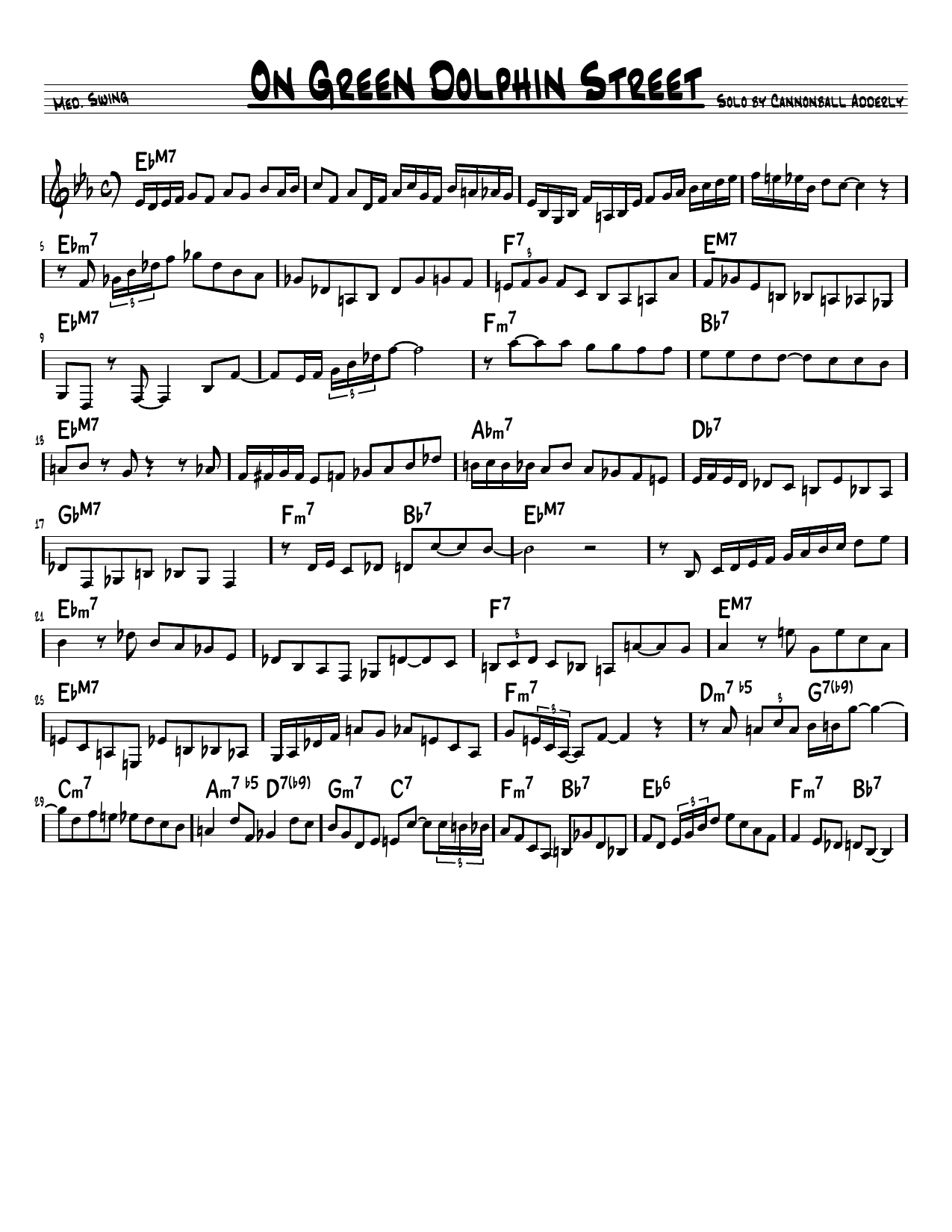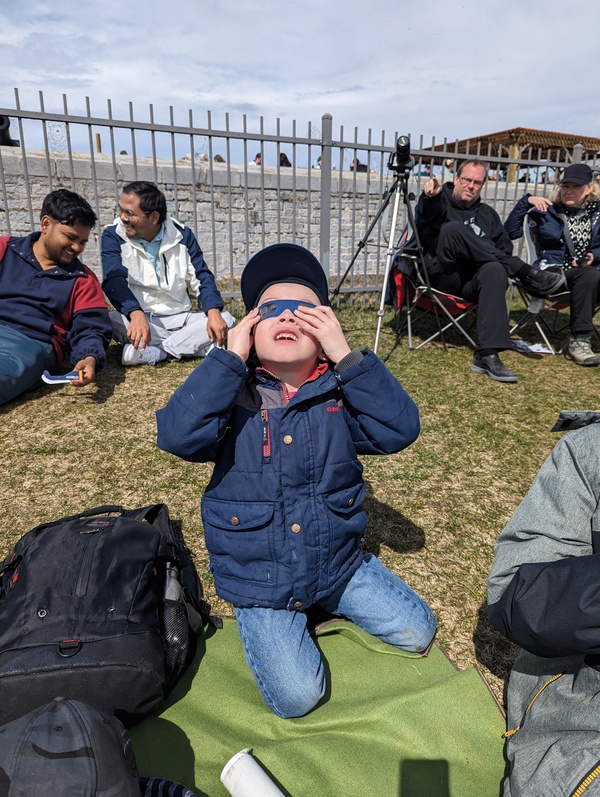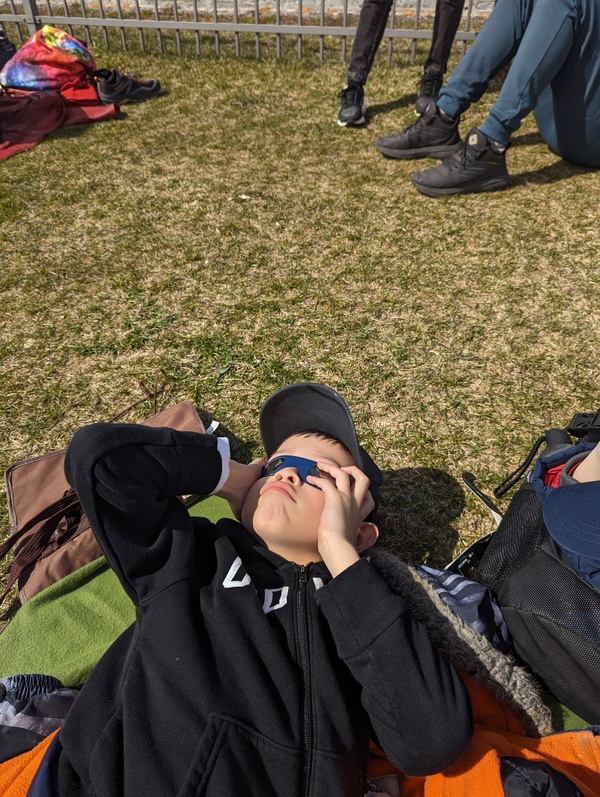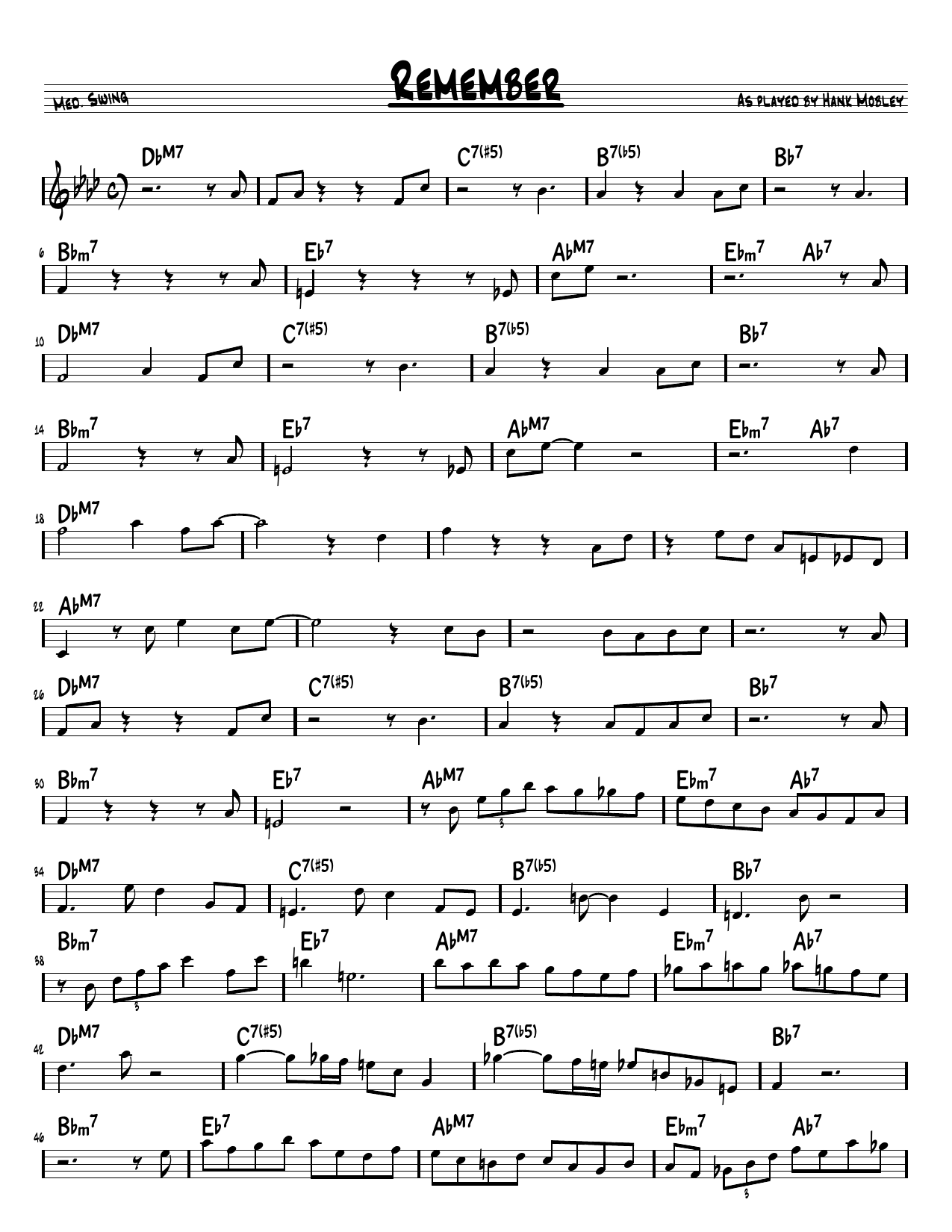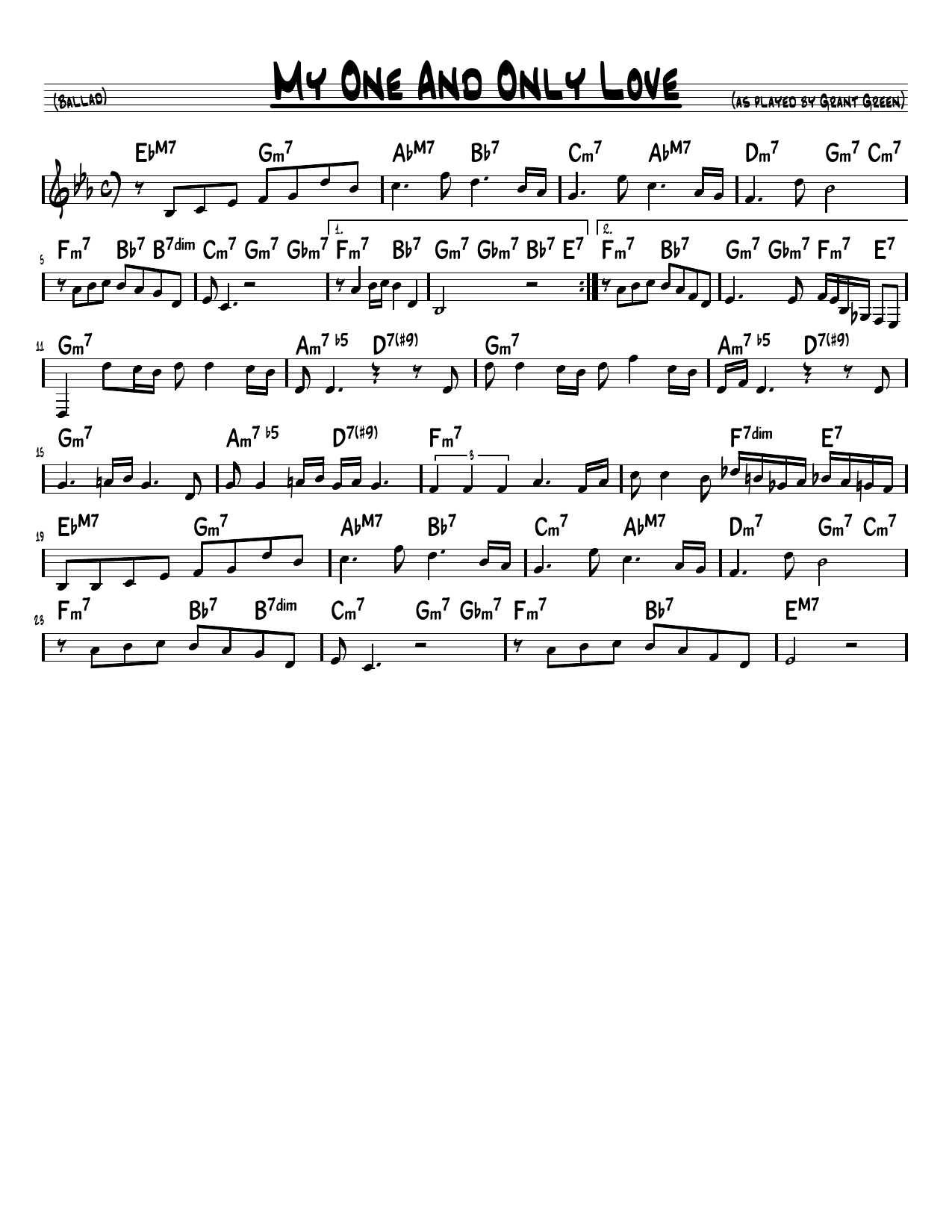For the last month I’ve been working on and off on the transcription of Cannonball Adderly’s first chorus of On Green Dolphin Street. The phrasing is really nice in this solo. Adderly plays around a lot with the time feel, at times playing way behind the beat which made writing out the rhythms challenging. I don’t think I really nailed it but if you listen along to the recording you get the idea.
Hole in the sky
The path of totality of the April 8, 2024 eclipse just barely missed our house, so I did what any extremely normal person would do: booked a hotel 4 months in advance two hours west of here, pre-ordered a dozen eclipse glasses, and then took a day off of work to go watch it.
Totally (ahem) worth it.
Most folks in this area headed out to Niagara Falls, but I gambled on Kingston being less packed. I drove the boys out there the day before. We checked in, then spent a bit of time walking around the lakefront near a pop-up eclipse store selling eclipse merch and playing eclipse-themed songs — of course “Total Eclipse of the Heart” and “Eclipse” from Dark Side of the Moon were featured, but I feel like there were still others? We had dinner in the chainiest of chains because any other restaurant was booked the whole night.
The weather forecast was cloudy, but we still expected crowds so we took the bus to the park — an hour plus odyssey with a transfer to travel less than an unwalkable mile. It ruined public transportation for my children forever. But we arrived.
…to a swarm of bugs populating Fort Henry. If I could do one thing over, we would have packed bug spray. These insects did not bite but hovered, everywhere, presumably tasting badly as none of the local birds bothered reducing their numbers. We huddled face-down on the blanket for the first few hours. Then we bought some overpriced hamburgers, played a few lawn games, and swallowed some more bugs to pass the time.
Eventually the moment of first contact arrived, and the clouds rolled in, dense enough to make the eclipsing sun a blurry, barely visible, disappointing smudge as viewed through the glasses. Alex moaned about the unfairness of the universe.
Ten minutes in, the clouds thinned, and the universe was fair again. We had a spectacular view of the encroaching moon. “This is amazing; also, please don’t blind us!” ran my inner monologue. “It’s a pac-man!” enthused Sam.
As the sun narrowed to a sliver, the clouds showed up again and dimmed the sun. Then it got cold: jackets back on. Then it got a bit darker. The clouds abated once more. With just a minute more to go, Ian began chanting, “To-tal-i-ty! To-tal-i-ty! To-tal-i-ty!” The sun disappeared from view. And everyone began cheering.
We took off the glasses to see the hole in the sky. A ring of light, with red dots on the edges. We would read later that those dots were solar prominences, hundreds of thousands of miles long. Far larger than one’s own worries.
I wouldn’t call the experience life-altering, but it is hard to describe. Reflecting a month later, my mind’s eye is incapable of fully reconstructing the image, but my brain supplies the deep chime of a carillon to underline the feeling of awe.
The moon continued on its way and the lights came back on to more cheering. Ian exclaimed, “that was the best three minutes of my life!” Alex hugged me euphorically. Sam said, “okay, now let’s get on the bus and go back home.” And so we did.
Or we tried. The bus route was late, or changed, or cancelled, so we spent a few hours waiting and talking with other stranded folks, sun getting its revenge by burning our skin, until we all gradually gave up and Ubered back.
Going faster slowly
For a while I’ve been using Amazing Slow Downer on the phone and PlayItSlowly on Linux for transcribing fast passages and to practice playing along with a tempo that I can manage. However, I frequently would like to just repetitively play a section a boatload of times while gradually increasing the BPM — without taking my hands off the fretboard to adjust a slider. So I wrote a thing.
#!/bin/bash
# play a segment of a song over and over, gradually
# increasing the tempo
file=$1
start=$2
end=$3
attempts=${4:-100}
start_speed=${5:-.5}
end_speed=${6:-1.0}
step=$(echo "scale=4; ($end_speed - $start_speed)/$attempts"| bc -l)
for t in $(seq $start_speed $step $end_speed); do
echo "*** $t ***"
mpv --no-video --start=$start --end=$end $file --o=/dev/stdout --of=ogg 2>/dev/null |
gst-launch-1.0 fdsrc fd=0 ! decodebin ! pitch tempo="$t" ! autoaudiosink >/dev/null 2>&1
done
Run it like so:
# between seconds 40 and 95, run 20 steps between half and full speed
./speedy.sh billies_bounce.ogg 40 95 20 .5 1
It would probably be nicer if the increase was logarithmic so you take smaller steps the faster it gets, but this worked out pretty well so far.
It’s kind of ridiculous to use mpv to segment the stream, but I couldn’t find a way to do windowing with just gst-launch (gnonlin seems to no longer be a thing) so, anyway, it works.
All the things I did
A belated happy 2024!
Most of my blog visitors are just bots spamming it with SQL injection attacks so this one goes out to any humans left out there. My job has been sucked into the generative AI vortex so I now work in an AI group at Amazon. If you’re reading this after an LLM became sentient and began rampaging… bwahahah, oh man, we’re nowhere near that… unless of course you are an investor and then yes sir I can magic your problem away.
As both of my human readers will know, in 2023 I posted a lot of jazz transcriptions and videos of myself playing them badly. This was very intentional as I decided to stop marveling at how one could make up solos on the spot, and to take some steps to learn the trick myself. My last guitar teacher (Berklee-trained) was very scale oriented, and so my improv really sounded like I was playing scales: very linear, no chromaticism and quite boring. It turns out I had a lot of misconceptions about how one does the thing — as I discovered, chord tones work better than scales; transcribing licks and solos by ear is not cheating but actually foundational; approach tones are key to getting the bebop sound. Besides transcribing, sitting down and working out all the arpeggios on a tune in one position, and composing a couple of solos really felt like they gave me a good boost in my playing. So I’m going to keep this going into 2024.
As a reference point, here’s where I am starting this year, on All the Things You Are in which the first chorus is composed and second half-chorus is improvised. Maybe I’ll check in again in 12 months and see how I improve.
Remember
November was a month to remember: we had Remembrance Day, and Guy Fawkes day, and well, just a whole lot of remembering things. I have been listening to a lot of hard bop, so naturally, I learned Remember, the Hank Mobley version.
Here’s take 1230912, post-workout edition, where I never could land that Ebm9 arpeggio in bar 49. I intentionally learned this in 5th position rather than 9th just to get some practice in a different area of the fretboard.
Four
I didn’t get very far on a transcription this month, owing to having a new project at work and especially due to Return To Office commute erasing 3 hours daily of what might have been practice time. This month’s transcription is the first chorus of Miles Davis’s Four. Frankly, it still needs work and really wants the next few choruses to sound complete, but putting a pin in it for now as I am out of time.
I didn’t record this one, either.
My One and Only Love
I am continuing to transcribe and learn a jazz standard each month to try and get better at this genre. And recording myself to keep myself honest.
March’s song is My One And Only Love because I thought, “why not try to learn a ballad?” I started by making a playlist (“My many one and only loves”) and listened to twenty versions of this song, settled on the version by Grant Green as the one to transcribe, and wrote it out (just melody this time — most recorded solos are generally embellishments of the melody). Green’s version has a slightly different melody and chords than the standard, and is in Eb instead of C.
I recently got a Focusrite Scarlett for recording and the audio quality difference is, unsurprisingly, night and day compared to just recording with my webcam mic. The guitar is straight into the Scarlett, then I am using Guitarix with a Fender Twin Reverb-like amp model to get the clean sound. The bass/drums are a JJazzlab midi track. I’m using pipewire in place of Jack to route and mix the audio sources. I’m really pleased with this setup, and after years of Linux audio being, well, Linux audio, it feels like pipewire finally got things right (even on the oldish version Debian stable ships that disclaims any responsibility).
Here’s a full song with improvised solo.
Things for me to work on after having watched myself:
- It’s a bit shaky on the B7 -> Bdim -> Cm transition. I kept missing the b5.
- I got a bit behind the chords on the last chorus and had to play catch-up.
- The solo is generally in the right key centers but not outlining the chords very well or having much development.
- I tend to play way behind the beat, even though (I think) I have it clicking away in my head. This is something I’ll need to focus on because it makes the whole thing sound sluggish and weird.
Although I still like the melody, I got bored of this one pretty early on, so next month I’ll pick another uptempo bebop standard to learn.
Confirmation part 2
I finished transcribing the first solo chorus to Confirmation and then went back and compared a few other transcriptions to fix some errors. I won’t claim mine is exact at this point, but it is as close as I can hear it. Meanwhile, I learned it on guitar and can kind of play it at about 80% tempo. There are some nice finger stretches and sweep picked arpeggios in this one. Parker’s swings way harder, of course.
Have a listen below.
Confirmation
Continuing on my goal to transcribe and learn a tune each month, I set Groovin’ High aside and transcribed the head of Parker’s Confirmation this weekend. On github as usual.
I took a quick scan of the internets and my transcription is pretty close, at least as far as the rhythms go. There are a few places where we disagree on notes, on some of the 16th triplets and a few bars in the bridge. I’ll have another listen and fix these things up as I have time.
The intro comes from Al Haig on whichever version I happened to have. I worked it out in front of the piano and can just play it with my terrible piano skills. Not sure about the chromatic descending minor chords since I can really only hear the bass notes on the recording but it doesn’t sound too bad.
Anyway, onto the solos…

Grooving not so high
Since last time I have been working on transcribing the solo on the tune Groovin’ High.
As a snapshot of where I am on this one, you can watch me creak my way through the solo over here:
There are a half dozen wrong notes and the last phrase is totally off, but, it’s getting there.
While at it, I wrote an arpeggio study for the chord changes and tried out lilypond’s built-in tablature renderer for this. The automatic numbering works well enough. I work out the fingering first and then tell it which string to use (otherwise it will pick fairly random positions with open strings), but at least it’s less likely to make a typo when you give note names instead of fret numbers.
Correction to my previous post, the sax player on this recording was (I think) Ernie Henry, not Charlie Parker. I do have one of the versions with Parker on it, but the recording quality is not great so this one is easier to listen to. It comes from the album Dizzy in Greece that I had from a compilation, so it took a lot of googling to figure out when it was originally released and who played on it.

